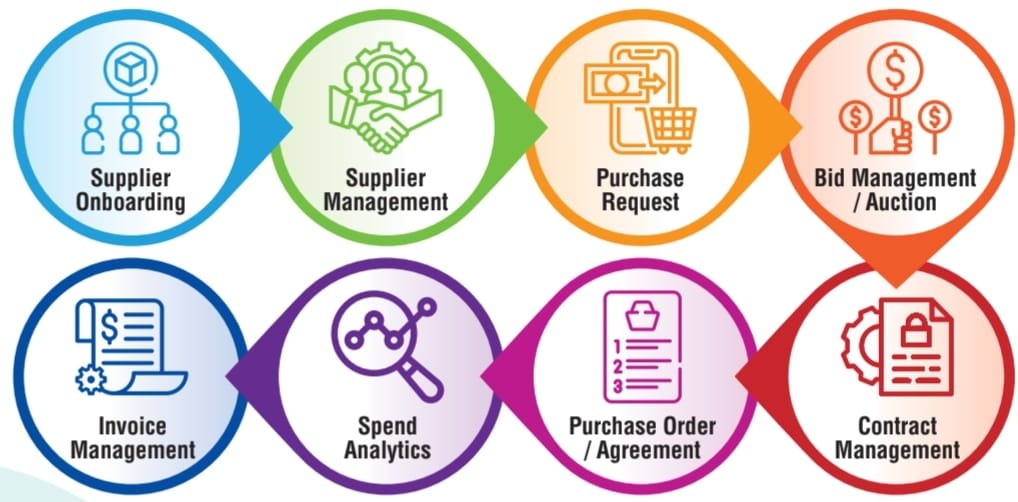ELIT P2P offers an integrated spend analytics solution, featuring a resilient and adaptable framework capable of seamlessly implementing and executing intricate spend analysis programs to achieve desired outcomes. With ELIT, you gain the ability to monitor indirect spend, mitigating potential challenges that could impede your spend analysis efforts. By leveraging ELIT, your organization can automate numerous manual processes and establish efficient safeguards for the procurement process.
The paramount objective for any business is to optimize costs and enhance bottom-line revenues, ultimately maximizing overall profits.
While businesses deploy various strategies to attain this goal, procurement functions can, and indeed do, play a pivotal role in contributing to the financial well-being of the organization.
Through the acquisition of necessary, essential, and integral goods and services vital for business and organizational growth, procurement functions emerge as critical elements in ensuring success for any business.
Procurement departments contribute significantly to organizational health by acquiring goods and services at lower or competitive prices, maximizing discounts through skillful negotiations, enhancing overall value, ensuring long-term benefits from purchases, and maintaining stability in cost containment. This multifaceted approach allows for cost savings and maximized efficiencies, directly bolstering the overall health of the organization.
However, the question arises: how can the procurement function contribute to effective success?
At the heart of success lies effective spend analysis. It’s quite straightforward: the more profound their understanding of business expenditures, budgets, and procurement costs for goods and services, the simpler it becomes to pinpoint areas for cost savings, elevate savings, and enhance overall value. Spend analysis, involving the systematic collection, examination, and visualization of spend data, encompasses several steps—from delineating business goals to identifying opportunities for curtailing unnecessary expenses and refining forecasting methodologies.
Effective spend analysis, however, is contingent upon the organizational scale, business nuances, and complexities. Hence, a robust, mature, and scalable technologically advanced system is not merely important but evolves into a fundamental necessity to guarantee adept spend analysis and management. The efficacy of spend analysis, therefore, hinges on the proficiency of the underlying spend analytics.
Spend analytics refers to the initial phases of spend analysis, encompassing data extraction, consolidation, cleansing, and classification based on predefined categories and taxonomies.
The advantages of effective spend analytics comprise facilitating spend visibility, uncovering opportunities for cost savings, simplifying forecasting and budgeting processes, identifying underperforming suppliers, streamlining internal procedures, and supporting benchmarking. Various factors may be utilized for conducting comprehensive comparisons.
Nevertheless, it is imperative to exercise caution and ensure that spend analytics is employed appropriately and at opportune moments to achieve the expected and desired outcomes. When crafting a robust spend analysis strategy and implementing a resilient spend analytics system, it is paramount to establish Key Performance Indicators (KPIs) for effective monitoring. Spend Analysis KPIs encompass savings, cost reduction, cost avoidance, maverick spending, contract compliance, process efficiency, and contribution to total spend.
After identifying diverse strategies, systems, processes, and performance indicators for effective spend analysis, the next step involves planning and determining the type of spend analytics to be implemented. These may include various categories such as indirect and direct spend, tail spend, category, item, supplier, contract, and payment spend analysis. A company can tailor its approach, focusing on a single type or conducting multiple analyses simultaneously, based on its specific goals.
With all considerations taken into account, the primary challenge lies in the execution of spend analysis. Typically, it involves a set of interdependent processes that must be standardized across the entire procurement function to ensure an effective spend analysis. Given the numerous steps and facets involved in spend analysis, a prudent approach is to commence with a small-scale initiative, focusing on a singular primary goal.
Step 1. Define Goals and Objectives
Step 2. Identify Relevant Spend Data Sources
Step 3. Extract and Consolidate Spend Data
Step 4. Cleanse and Enrich Spend Data
Step 5. Classify Spend Data
Step 6. Analyse Spend Data
Step 7. Visualize the Results of the Analysis
A handful of guidelines to ensure optimal effectiveness include adopting best practices. Employ these best practices to further enhance your procurement spend analysis program:
- Start with a strong process
- Enlist a champion
- Use data to strategize solutions
One persistent concern businesses frequently face and question is the realistic effectiveness of spend analysis programs. Indeed, these programs can encounter setbacks and occasional failures, resulting in more complications than businesses initially anticipated.
Identifying the common reasons behind the failure of spend analysis programs and the typical setbacks they encounter is crucial for designing and executing an effective program with a high success rate and desired outcomes. Spend analysis is a complex process demanding utmost attention and dedication from those involved. Some common pitfalls include managing a massive amount of spend data, decentralized data storage, low-quality data, and a shortage of skills.
Moreover, spend analysis hinges on consistency and accuracy throughout the organization. Numerous ineffective spend management practices falter due to these common issues:
- Lack of process
- Inconsistent data collection
- Manual administration
ELIT P2P offers an integrated spend analytics solution with a robust and flexible framework, facilitating the implementation and execution of even complex spend analysis programs to achieve desired outcomes. With ELIT, you can effectively monitor indirect spending, mitigating challenges that could derail your spending analysis efforts. By leveraging ELIT, your organization can automate numerous manual processes and establish efficient guardrails for purchasing.

To know more about how specifically ELIT can benefit your business, log on to elit.ai or email info@eit.ai for a representative to get in touch with you.
You can also download the ELIT brochure here
INTERESTED TO KNOW MORE?
CLICK THE BELOW BUTTON TO SCHEDULE A DEMO WITH US!





